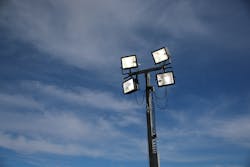One of the most prominent trends within the light tower industry today is the shift from metal halide lamps to LED lighting. The most significant advantage of LEDs when compared to traditional lighting solutions is the long lifespan. An LED bulb typically guarantees 10,000 hours of use at its full light output, whereas metal halide bulbs lose 50 percent of their light output within the same timeframe.
LED bulbs can also be switched on-and-off instantly, providing customers with a more time-efficient lighting solution. A metal halide bulb on the other hand, has to reach several thousands of degrees in temperature before it can operate—meaning it can take up to 5 minutes to reach full power.
“Metal halide lights take a while to warm up to be at full brightness,” Eric Massinon, business development manager at Chicago Pneumatic says. “When you shut them off, users have to wait for the lights to cool down—sometimes up to a half hour before you can turn them back on.”
Since LEDs emit almost no heat they are also less fire-prone, making them the safer bulb option when used with light towers.
The Color Rendering Index (CRI) is the measurement of how colors look under a light source when compared with sunlight. The index is measured from zero to 100, with a perfect 100 indicating that colors under the light source appear the same as they would under natural sunlight. In terms of CRI for LEDs, most LED lights produce a score of about 80 to 90 on the chart. This results in a brighter workspace, with a more accurate output of light.
“The index measures the quality of the light compared to sunlight, with sunlight being the most ‘perfect’ light,” says Erin Brown, Doosan Portable power’s senior product specialist. “LEDs are closer to natural sunlight and metal halide, and are the overall better perceived light.”
“Because the color of LEDs is closer to that of daylight than the yellowish hue of halogens, it appears brighter and can illuminate details of objects in the distance better,” according to AGC.
Metal halide creates all sorts of light, in all spectrums, visible or otherwise. This includes UV and IR spectrums, which is visible to the measuring device, but not to humans. LED bulbs do not produce UV and IR, meaning all light produced by an LED is visible to the human eye.
LEDs also help construction workers see more “at the edge of the scene,” according to AGC, where traditional lamps tend to “fade out.” This improves safety and eyestrain since it helps workers spot potential dangers and important details.
“Overall light looks better,” Brown says. “You don't get that big hot spot that you do under a metal halide. Even if you’re outside, you can look around and see that the LEDs create a more even lighting with less shadowing, especially on the outer perimeter of the lighting footprint.”
Brown expects all light towers to come with LED lights within three to five years. Doosan Portable currently sells 70 to 80 percent of its light towers with LED fixtures, she says.





